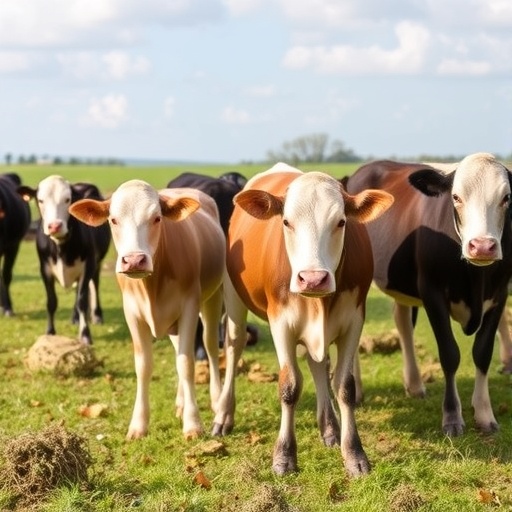Across the globe, dairy farming faces mounting pressure to balance productivity with environmental stewardship. Recent research from the University of Göttingen offers a nuanced perspective on one commonly advocated approach: grazing dairy cows on pastures rich in botanical diversity. This strategy, often touted for its environmental and productivity benefits, has been rigorously examined through a comprehensive meta-analysis, providing pivotal insights that challenge some prevailing assumptions in sustainable agriculture.
Grazing dairy cows on diverse pastures aligns with nature-centric farming practices, fostering ecosystems that promote biodiversity, enhance soil integrity, and contribute to carbon sequestration. However, the benefits of such grazing systems in terms of direct agricultural outputs, namely milk production and methane emissions from enteric fermentation, have remained equivocal. The research team, led by Dr. Martin Komainda at the University of Göttingen’s Institute of Grassland Science, meticulously analyzed data spanning 16 studies to dissect these complex interactions.
Their meta-analysis compared species-rich pastures—those with a rich assemblage of grasses, herbs, and legumes—against simpler, less diverse grasslands. Contrary to expectations, the results indicated that increased botanical diversity did not translate into significant changes in milk yield nor a reduction in methane emissions. This counterintuitive finding suggests that the ecological complexity of pastures alone is not a panacea for enhancing dairy productivity or mitigating greenhouse gas outputs.
Central to the discussion is the role of legumes—plants in the fabaceae family such as clover and chicory—which hold a unique position in pasture ecosystems due to their nitrogen-fixing capabilities and high nutritional value. The analysis indicated that the proportion of legumes within the pasture mix is a more critical determinant of milk production than overall species richness. Legume presence correlated positively with higher milk yields, underscoring the importance of botanical composition over diversity per se.
These findings invite a reassessment of pasture management priorities. While ecological diversity remains vital for sustaining the broader ecosystem services of agricultural landscapes, such as supporting pollinators and enhancing soil microbial communities, it may not reliably influence certain production metrics within short-term frameworks. The study highlights a crucial methodological limitation: the majority of analyzed studies were brief, with ten lasting ten days or fewer, potentially missing seasonal and inter-annual variability that impacts pasture quality and animal performance.
Grassland productivity and quality fluctuate markedly over time, influenced by environmental factors such as temperature, precipitation, and soil fertility. Short-duration experiments may fail to capture these dynamics, limiting the ability to discern longer-term effects of plant diversity on livestock outcomes. The researchers advocate for extended, year-round and multi-year studies to better understand the temporal dimensions of grassland-livestock interactions.
Methane emissions, predominantly arising from ruminal fermentation in cows, remain a significant challenge in livestock agriculture due to their potent greenhouse effect. The meta-analysis found no consistent relationship between pasture diversity and methane output, partially attributed to the rarity of specific plant species known to modulate methane production in bovine diets across the studied fields. This highlights the complexity of biogenic methane mitigation, which involves intricate interactions among diet composition, rumen microbiota, and animal physiology.
Despite the lack of clear evidence linking diverse pastures to reduced methane emissions or enhanced milk production, the authors emphasize the manifold ecosystem services provided by botanical diversity in pastures. These include habitat provision for wildlife, improved nutrient cycling, and resilience against pests and diseases. Such benefits contribute to the sustainability and long-term viability of farming systems beyond simple production metrics.
The research further contextualizes its findings within the realities faced by farmers, who must navigate environmental variability and economic pressures. Pasture composition that strategically incorporates legumes offers a practical intervention to optimize milk yield, while maintaining ecosystem health. This balanced approach allows for the stewardship of agricultural landscapes without compromising productivity.
The study’s conclusions prompt a more nuanced dialogue about sustainable grassland management. Rather than pursuing botanical diversity solely for immediate gains in milk output or methane reduction, farmers and policymakers should appreciate the broader ecological, economic, and social benefits embedded within diverse pastures. This holistic perspective fosters farming systems resilient to climatic variability and aligned with global sustainability goals.
In drawing these insights, the University of Göttingen team contributes significantly to the discourse on agricultural intensification versus ecological conservation. Their work encourages innovation in pasture management practices that integrate scientific knowledge with pragmatic considerations, shaping the future of sustainable dairy farming.
This research was supported by the Federal Ministry of Food, Agriculture and Home Affairs, reflecting the strategic importance of advancing agricultural sustainability through evidence-based practices. The team’s findings have been published in the journal Food and Energy Security, illustrating the critical intersections of food production, environmental health, and energy dynamics in contemporary agronomy.
As the dairy sector grapples with its environmental footprint, this research underscores the need for continued exploration into the multifaceted relationships between pasture ecosystems and livestock productivity. It advocates for longitudinal studies that can unravel the temporal complexities influencing both ecological and agronomic outcomes, vital for informing policies and practices that harmonize farming productivity with climate action imperatives.
Subject of Research: Not applicable
Article Title: Boosting Grassland Output and Lowering Methane Emission by Grazing Dairy Cows on Diverse Pastures?
News Publication Date: 20-Aug-2025
Web References:
https://onlinelibrary.wiley.com/doi/10.1002/fes3.70113
References:
Komainda, M., Riesch, F. & Isselstein, J. Boosting Grassland Output and Lowering Methane Emission by Grazing Dairy Cows on Diverse Pastures? Food and Energy Security (2025). DOI: 10.1002/fes3.70113
Image Credits:
Martin Komainda
Keywords:
Conventional farming, Dairy products, Milk, Agricultural intensification, Agriculture, Agricultural policy, Grasslands, Grassland ecosystems, Atmospheric methane, Methane, Environmental issues, Climate change, Farming, Sustainable agriculture




